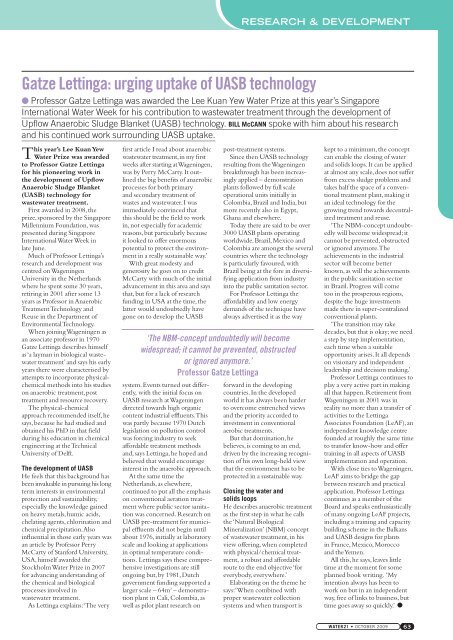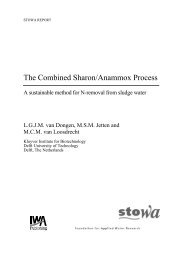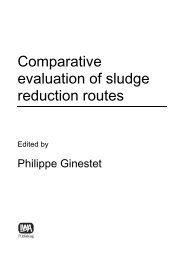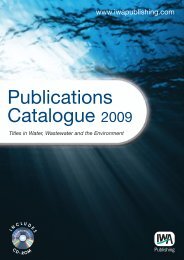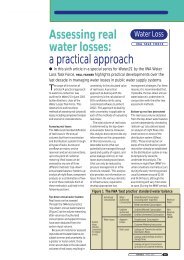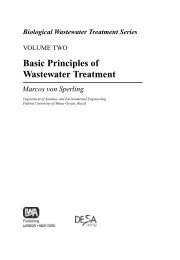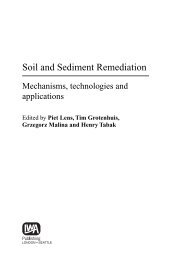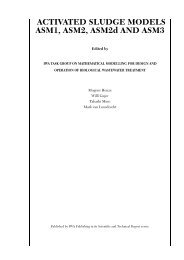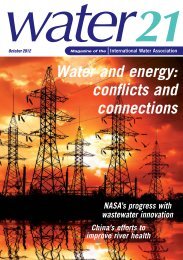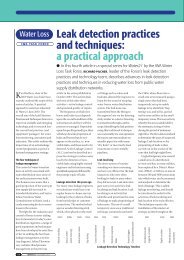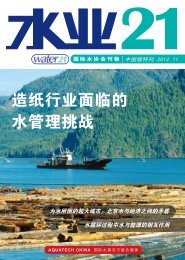here - IWA Publishing
here - IWA Publishing
here - IWA Publishing
You also want an ePaper? Increase the reach of your titles
YUMPU automatically turns print PDFs into web optimized ePapers that Google loves.
RESEARCH & DEVELOPMENT<br />
Gatze Lettinga: urging uptake of UASB technology<br />
● Professor Gatze Lettinga was awarded the Lee Kuan Yew Water Prize at this year’s Singapore<br />
International Water Week for his contribution to wastewater treatment through the development of<br />
Upflow Anaerobic Sludge Blanket (UASB) technology. BILL McCANN spoke with him about his research<br />
and his continued work surrounding UASB uptake.<br />
This year’s Lee KuanYew<br />
Water Prize was awarded<br />
to Professor Gatze Lettinga<br />
for his pioneering work in<br />
the development of Upflow<br />
Anaerobic Sludge Blanket<br />
(UASB) technology for<br />
wastewater treatment.<br />
First awarded in 2008,the<br />
prize,sponsored by the Singapore<br />
Millennium Foundation,was<br />
presented during Singapore<br />
InternationalWaterWeek in<br />
late June.<br />
Much of Professor Lettinga’s<br />
research and development was<br />
centred onWageningen<br />
University in the Netherlands<br />
w<strong>here</strong> he spent some 30 years,<br />
retiring in 2001 after some 13<br />
years as Professor in Anaerobic<br />
TreatmentTechnology and<br />
Reuse in the Department of<br />
EnvironmentalTechnology.<br />
When joiningWageningen as<br />
an associate professor in 1970<br />
Gatze Lettinga describes himself<br />
as‘a layman in biological wastewater<br />
treatment’and says his early<br />
years t<strong>here</strong> were characterised by<br />
attempts to incorporate physicalchemical<br />
methods into his studies<br />
on anaerobic treatment,post<br />
treatment and resource recovery.<br />
The physical-chemical<br />
approach recommended itself,he<br />
says,because he had studied and<br />
obtained his PhD in that field<br />
during his education in chemical<br />
engineering at theTechnical<br />
University of Delft.<br />
The development of UASB<br />
He feels that this background has<br />
been invaluable in pursuing his long<br />
term interests in environmental<br />
protection and sustainability,<br />
especially the knowledge gained<br />
on heavy metals,humic acids,<br />
chelating agents,chlorination and<br />
chemical precipitation.Also<br />
influential in those early years was<br />
an article by Professor Perry<br />
McCarty of Stanford University,<br />
USA,himself awarded the<br />
StockholmWater Prize in 2007<br />
for advancing understanding of<br />
the chemical and biological<br />
processes involved in<br />
wastewater treatment.<br />
As Lettinga explains:‘The very<br />
first article I read about anaerobic<br />
wastewater treatment,in my first<br />
weeks after starting atWageningen,<br />
was by Perry McCarty.It outlined<br />
the big benefits of anaerobic<br />
processes for both primary<br />
and secondary treatment of<br />
wastes and wastewater.I was<br />
immediately convinced that<br />
this should be the field to work<br />
in,not especially for academic<br />
reasons,but particularly because<br />
it looked to offer enormous<br />
potential to protect the environment<br />
in a really sustainable way.’<br />
With great modesty and<br />
generosity he goes on to credit<br />
McCarty with much of the initial<br />
advancement in this area and says<br />
that,but for a lack of research<br />
funding in USA at the time,the<br />
latter would undoubtedly have<br />
gone on to develop the UASB<br />
system.Events turned out differently,<br />
with the initial focus on<br />
UASB research atWageningen<br />
directed towards high organic<br />
content industrial effluents.This<br />
was partly because 1970 Dutch<br />
legislation on pollution control<br />
was forcing industry to seek<br />
affordable treatment methods<br />
and,says Lettinga,he hoped and<br />
believed that would encourage<br />
interest in the anaerobic approach.<br />
At the same time the<br />
Netherlands,as elsew<strong>here</strong>,<br />
continued to put all the emphasis<br />
on conventional aeration treatment<br />
w<strong>here</strong> public sector sanitation<br />
was concerned.Research on<br />
UASB pre-treatment for municipal<br />
effluents did not begin until<br />
about 1976,initially at laboratory<br />
scale and looking at applications<br />
in optimal temperature conditions.<br />
Lettinga says these comprehensive<br />
investigations are still<br />
ongoing but,by 1981,Dutch<br />
government funding supported a<br />
larger scale – 64m 3 – demonstration<br />
plant in Cali,Colombia,as<br />
well as pilot plant research on<br />
post-treatment systems.<br />
Since then UASB technology<br />
resulting from theWageningen<br />
breakthrough has been increasingly<br />
applied – demonstration<br />
plants followed by full scale<br />
operational units initially in<br />
Colombia,Brazil and India,but<br />
more recently also in Egypt,<br />
Ghana and elsew<strong>here</strong>.<br />
Today t<strong>here</strong> are said to be over<br />
3000 UASB plants operating<br />
worldwide.Brazil,Mexico and<br />
Colombia are amongst the several<br />
countries w<strong>here</strong> the technology<br />
is particularly favoured,with<br />
Brazil being at the fore in diversifying<br />
application from industry<br />
into the public sanitation sector.<br />
For Professor Lettinga the<br />
affordability and low energy<br />
demands of the technique have<br />
always advertised it as the way<br />
‘The NBM-concept undoubtedly will become<br />
widespread; it cannot be prevented, obstructed<br />
or ignored anymore.’<br />
Professor Gatze Lettinga<br />
forward in the developing<br />
countries.In the developed<br />
world it has always been harder<br />
to overcome entrenched views<br />
and the priority accorded to<br />
investment in conventional<br />
aerobic treatments.<br />
But that domination,he<br />
believes,is coming to an end,<br />
driven by the increasing recognition<br />
of his own long-held view<br />
that the environment has to be<br />
protected in a sustainable way.<br />
Closing the water and<br />
solids loops<br />
He describes anaerobic treatment<br />
as the first step in what he calls<br />
the‘Natural Biological<br />
Mineralization’(NBM) concept<br />
of wastewater treatment,in his<br />
view offering,when completed<br />
with physical/chemical treatment,<br />
a robust and affordable<br />
route to the end objective‘for<br />
everybody,everyw<strong>here</strong>.’<br />
Elaborating on the theme he<br />
says:‘When combined with<br />
proper wastewater collection<br />
systems and when transport is<br />
kept to a minimum,the concept<br />
can enable the closing of water<br />
and solids loops.It can be applied<br />
at almost any scale,does not suffer<br />
from excess sludge problems and<br />
takes half the space of a conventional<br />
treatment plant,making it<br />
an ideal technology for the<br />
growing trend towards decentralized<br />
treatment and reuse.<br />
‘The NBM-concept undoubtedly<br />
will become widespread;it<br />
cannot be prevented,obstructed<br />
or ignored anymore.The<br />
achievements in the industrial<br />
sector will become better<br />
known,as will the achievements<br />
in the public sanitation sector<br />
in Brazil.Progress will come<br />
too in the prosperous regions,<br />
despite the huge investments<br />
made t<strong>here</strong> in super-centralized<br />
conventional plants.<br />
‘The transition may take<br />
decades,but that is okay;we need<br />
a step by step implementation,<br />
each time when a suitable<br />
opportunity arises.It all depends<br />
on visionary and independent<br />
leadership and decision making.’<br />
Professor Lettinga continues to<br />
play a very active part in making<br />
all that happen.Retirement from<br />
Wageningen in 2001 was in<br />
reality no more than a transfer of<br />
activities to the Lettinga<br />
Associates Foundation (LeAF),an<br />
independent knowledge centre<br />
founded at roughly the same time<br />
to transfer know-how and offer<br />
training in all aspects of UASB<br />
implementation and operation.<br />
With close ties toWageningen,<br />
LeAF aims to bridge the gap<br />
between research and practical<br />
application.Professor Lettinga<br />
continues as a member of the<br />
Board and speaks enthusiastically<br />
of many ongoing LeAF projects,<br />
including a training and capacity<br />
building scheme in the Balkans<br />
and UASB designs for plants<br />
in France,Mexico,Morocco<br />
and theYemen.<br />
All this,he says,leaves little<br />
time at the moment for some<br />
planned book writing. ‘My<br />
intention always has been to<br />
work on but in an independent<br />
way,free of links to business,but<br />
time goes away so quickly.’ ●<br />
WATER21 •• OCTOBER MONTH 20XX 2009 00 63
RESEARCH & DEVELOPMENT<br />
Carbon neutral sewer repairs<br />
UK company Wessex<br />
Water has reported on<br />
the successful trial use of a<br />
carbon emissions calculator<br />
developed in Canada.<br />
Developed by Dr Mark Knight<br />
ofWaterloo University,Canada,<br />
the calculator and its capabilities<br />
were introduced to the company<br />
through the International Society<br />
forTrenchlessTechnology (ISTT)<br />
and were initially tested on a<br />
contract for trenchless repair of a<br />
1000m length of sewer in Bristol,<br />
south-west England.<br />
WessexWater Project<br />
Engineer,Julian Britton,said this<br />
first use of the calculator in the<br />
UK had indicated that the<br />
trenchless relining of the sewer<br />
had saved 97% of the carbon<br />
emissions that would have been<br />
attracted by the conventional<br />
open cut method.<br />
Britton believed this to be<br />
the only tool currently available<br />
for such calculations and said<br />
it operated on the basis of<br />
input data that included not<br />
only,in this case,the length<br />
and diameter of the sewer<br />
concerned,but also the duration<br />
of the contract and details of<br />
traffic volumes.This latter<br />
enabled the output result to<br />
include an allowance for<br />
emission savings from reduced<br />
traffic congestion.<br />
With over 7000m of sewers<br />
repaired by trenchless methods<br />
during the past yearWessex is<br />
constantly searching for advances<br />
in this area and is,at the same<br />
time,working to make it’s<br />
trenchless operations as nearly<br />
possible‘carbon neutral.’<br />
In both these objectives<br />
Britton says the company<br />
derives great benefit from<br />
sharing ideas with ISTT.<br />
In the Bristol contract use of<br />
Saving carbon with variable speed<br />
In a study of the carbon<br />
emissions savings to be<br />
made from use of variable<br />
speed drives industrial motor<br />
manufacturer ABB claims to<br />
show that variable speed<br />
control on a 250kW motor<br />
can compensate for the<br />
emissions from manufacture<br />
and disposal in just half of<br />
one operating day.<br />
Made in conjunction with<br />
Finland’sTampere University of<br />
Technology the study was based<br />
on three motor sizes – 0.75kW,<br />
7.5kW and 250kW – and showed<br />
that payback time reduced in<br />
inverse proportion to motor size.<br />
Estimated time to overcome<br />
manufacture and disposal<br />
emissions was put at 1.1 days for<br />
the medium sized motor and six<br />
days for the smallest unit.<br />
In the context of reducing<br />
carbon footprint ABB make the<br />
point that a positive contribution<br />
to the environment comes only<br />
after the early savings from<br />
variable speed control have<br />
reached the total emissions<br />
arising from manufacture and<br />
disposal of the unit.<br />
Once that point is reached the<br />
motor will make continuous<br />
savings,and the operator will<br />
have a reduced carbon footprint,<br />
throughout the operating life of<br />
the unit.In the case of the<br />
Dealing with diffuse nitrates<br />
Anew approach to dealing<br />
with diffuse nitrate<br />
pollution from agriculture<br />
has been successfully tested at<br />
a site in Northern Ireland<br />
w<strong>here</strong> it proved able to<br />
reduce the nitrate<br />
concentration of shallow<br />
groundwater by over 90%.<br />
Supported by the European<br />
Commission’s LIFE financial<br />
instrument,the NITRABAR<br />
process is,in effect,a cut-off<br />
trench that intercepts the shallow<br />
groundwater as it flows towards<br />
the river or other water body.<br />
The trench and its fill material<br />
form what is described as a<br />
permeable reactive barrier in<br />
which iron or other metals or<br />
minerals are mixed with readily<br />
available carbon substrates such<br />
as tree bark,wood chippings or<br />
leaf compost.This creates an<br />
environment in which the<br />
micro-organisms naturally<br />
present in the soil and groundwater<br />
can flourish to speed the<br />
denitrification process,reducing<br />
the dissolved nitrate in the<br />
groundwater to gaseous nitrogen.<br />
In practical application the<br />
reactive barrier is preceded with<br />
a permeable gravel chamber to<br />
aid the collection and passage of<br />
water from field drains and near<br />
surface layers.<br />
While many management<br />
options now assist the farmer in<br />
reducing the adverse environmental<br />
impacts of current applications of<br />
fertiliser or manure the unique<br />
attribute of NITRABAR is that<br />
it will deal with the nitrates<br />
leaching slowly into water bodies<br />
from surface applications made<br />
possibly as long as 20 or 30 years ago.<br />
The 46-month project started<br />
in December 2005.Professor<br />
Robert Kalin of the UK’s<br />
250kW motor studied <strong>here</strong> the<br />
lifetime savings were put at<br />
7500MWh or 3800 tonnes of<br />
carbon dioxide emissions.<br />
Speaking about the findings,<br />
Steve Ruddell,ABB General<br />
Manager in the UK,said he<br />
believed that purchaser investment<br />
decisions currently based<br />
purely on financial considerations<br />
would,within the next five years,<br />
have to give equal consideration<br />
to the emissions factor.‘T<strong>here</strong><br />
will be a sea change in the way<br />
companies look at investment<br />
decisions and they will be just as<br />
keen to save carbon dioxide as<br />
they are saving money today,’he<br />
said.‘Our study shows that using<br />
Strathclyde University designed<br />
the system and led the research<br />
team,which included partners<br />
from Belgium,Malta and Poland.<br />
Monitoring and data collection at<br />
the Northern Ireland test site<br />
began in early 2008.<br />
The tests showed that the<br />
method is cost-effective when<br />
compared with other available<br />
methods of dealing with diffuse<br />
nitrate pollution and a significant<br />
advantage is that it is the<br />
only option for dealing<br />
with historic pollution.<br />
Another important advantage<br />
is that,once installed,the<br />
trench does not impede<br />
normal field operations.<br />
It was also concluded that<br />
NITRABAR is an effective<br />
means of maintaining agricultural<br />
land in production and allowing<br />
agriculture to continue,particularly<br />
in high nitrate areas.<br />
heat cured liners contributed to<br />
the saving of harmful emissions<br />
and he believes even greater<br />
savings will become apparent<br />
when the most recent<br />
methods of curing linings<br />
are brought into play.<br />
These include‘melt in place’<br />
thermoplastic liners and UV light<br />
curing – the latter a technique<br />
thatWessexWater is planning to<br />
introduce during 2010.●<br />
Further information: Press<br />
Officer, Wessex Water<br />
Email: Clare-Marie.Dobing@<br />
wessexwater.co.uk<br />
variable speed drives is one of<br />
the most cost-effective measures<br />
to achieve rapid and radical<br />
CO 2 reductions.’<br />
The study noted that nearly<br />
70% of all industrial electricity<br />
consumption is in motor<br />
drives and an estimated 20%<br />
of that is wasted by use of<br />
external throttling devices to<br />
control flow of air or liquids<br />
in pipes or ducts rather than<br />
variable speed drives to<br />
control the motors. ●<br />
Further information: Steve<br />
Ruddell, ABB Limited,<br />
Warrington, Cheshire, UK.<br />
Email: energy@gb.abb.com<br />
Amongst the perceived<br />
limitations of the system are<br />
the limited residence time<br />
within the permeable barrier<br />
and the unknown time limit<br />
on sustaining effective<br />
denitrification before the<br />
carbon source needs replenishing.<br />
In the project closing report<br />
it is noted that,although this<br />
study centred on nitrate<br />
pollution in agriculture the<br />
system might equally be<br />
applied in a number of other<br />
roles,including dealing with<br />
diffuse phosphate or<br />
pesticide pollution or<br />
acting as a protective barrier<br />
to treat contaminated<br />
groundwater emanating<br />
from industrial sites.●<br />
Further information:<br />
Professor Robert Kalin.<br />
Email: Robert.Kalin@Strath.ac.uk<br />
64<br />
WATER21 • OCTOBER 2009
An alternative filtration process for sludge separation<br />
MESH, a process which uses textile<br />
filter fabrics to separate treated water<br />
from activated sludge, is being<br />
investigated as part of a membrane<br />
bioreactor development in wastewater<br />
treatment. CHRISTIAN LODERER<br />
explains how his new approach works<br />
and the positive results from the pilot<br />
study.<br />
At the Institute for<br />
Environmental<br />
Biotechnology at IFA-Tulln,<br />
an applied research centre in<br />
Austria, a new process is<br />
under investigation that can<br />
bring a significant stimulus<br />
to membrane bioreactor<br />
(MBR) development.<br />
MBR technology has lately<br />
attracted significant attention as<br />
an improved wastewater treatment<br />
process offering significant<br />
advantages in terms of a reduced<br />
footprint as well as a superior<br />
effluent quality.However the<br />
higher energy demand compared<br />
to standard processes is still a<br />
major hindrance for more<br />
widespread applications.The<br />
innovative approach,developed<br />
by ProfessorWerner Fuchs and<br />
his group,uses textile filter<br />
Water21nternet<br />
The new interactive‘Water in Storages’<br />
website is being updated weekly to show<br />
water availability in public water storages<br />
across the Murray-Darling Basin,<br />
Australia.The Murray-Darling Basin<br />
Authority (MDBA) developed the new<br />
site,which includes data collated from<br />
water management sources in the four<br />
Basin states.Minister for Climate Change<br />
andWater,Senator PennyWong said:<br />
‘Water managers,irrigators,community<br />
and environment groups,students,and<br />
anyone else with an interest can just click<br />
on an interactive map of the Basin for the<br />
latest data on water held in public storage<br />
anyw<strong>here</strong> in the Basin.They can also<br />
check the current volume of water in<br />
each storage facility expressed as a figure<br />
and a percentage.And for the River<br />
Murray,current storage levels can be<br />
compared against historical comparisons<br />
at the click of a mouse.Visitors will also<br />
be able to access information on the latest<br />
seasonal water allocations via links to each<br />
relevant State water agency.’In response<br />
to public interest,the water volume and<br />
level of South Australia’s Lower Lakes will<br />
fabrics to separate the treated<br />
water from the activated sludge.<br />
The concept of MESH,as the<br />
process was termed,is based on<br />
three important facts.<br />
Activated sludge appears in<br />
the form of flocs,which is a<br />
result of physicochemical<br />
interactions between<br />
micro-organisms,extracellular<br />
substances and inorganic<br />
particles.The floc size,ranges<br />
from 20 to more than 500 µm.<br />
Instead of membranes with<br />
usual pores sizes less than 0.2 µm,<br />
coarser filter material can<br />
be used to separate the<br />
activated sludge from the<br />
treated wastewater.<br />
The retention of sludge<br />
flocs leads to the formation<br />
of a secondary layer or dynamic<br />
membrane on the filter surface.<br />
This additional filter layer retains<br />
particles even smaller than the<br />
nominal mesh size.<br />
Because of their significantly<br />
larger pore size these filters<br />
experience almost no filter<br />
resistance.In consequence,<br />
much higher flow rates can<br />
be achieved and the operational<br />
pressure for such a system<br />
also be viewable on the website and<br />
updated weekly.<br />
www.mdba.gov.au/water/waterinstorage<br />
is much lower compared<br />
to membranes.<br />
A feasibility study on the<br />
process was made within a<br />
European Commission-funded<br />
project by a consortium of<br />
eight European partners<br />
from industry and research.<br />
A 160 population equivalent<br />
pilot plant equipped with<br />
two modules housing tubular<br />
filter elements with a mesh<br />
size of 29 µm was successfully<br />
operated for one year.The<br />
effective filter area was 14 m 2 .<br />
The filtration was operated in<br />
a cyclic mode with 30 minutes<br />
of filtration followed by a<br />
hydraulic cleaning step that<br />
includes permeate backwashing<br />
and air sparging.<br />
Within the pilot study,it<br />
was demonstrated that<br />
permanent high flux rates of<br />
90 up to 150 l/m 2 .h can be<br />
obtained and that the effluent<br />
quality complies well with all<br />
European regulations.<br />
Moreover,the energy<br />
consumption per cubic metre<br />
of permeate process is half that<br />
of an MBR and at the same level<br />
as an activated sludge process.<br />
The European Rainwater Catchment<br />
Systems Association (ERCSA) has<br />
launched a new website,which details<br />
projects being undertaken by ERCSA<br />
worldwide,as well as information on<br />
upcoming conferences and factsheets on<br />
rainwater harvesting.<br />
www.ercsa.eu<br />
The US Environmental Protection<br />
Agency (EPA) is now on the blogging<br />
websiteTwitter.Recent additions to the<br />
EPA website can be followed at:<br />
http://twitter.com/EPAweb<br />
Available for download fromWater<br />
SavingWeek’s website is a water footprint<br />
assessor which allows you to calculate not<br />
just how much clean water per day you<br />
use,but also the amount of water involved<br />
in the production of everyday items and<br />
the food and drink we consume.The<br />
Water SavingWeek,which was held 17-<br />
The MESH filter bioreactor<br />
has considerable potential as<br />
a wastewater treatment<br />
process w<strong>here</strong> a small area<br />
requirement is of high priority.<br />
It provides similar advantages<br />
as membrane bioreactors<br />
with regard to elevated sludge<br />
concentration and volumetric<br />
loading rates resulting in a<br />
reduced area requirement.At<br />
the same time an effluent quality<br />
equal to well operated standard<br />
activated sludge systems can<br />
be achieved. ●<br />
About the author<br />
Christian Loderer, University of<br />
Natural Resources and Applied<br />
Life Sciences (BOKU), Vienna,<br />
Austria. Email: christian.<br />
loderer@boku.ac.at<br />
Study pilot plant.<br />
23 July 2009,highlighted the fact that we<br />
each,on average,use 3400 litres through<br />
agricultural crops,1095 litres through<br />
manufactured products and 150 litres in<br />
the home.<br />
www.watersavingweek.org.uk<br />
UN-Water has added a new page onto its<br />
website which brings together educational<br />
materials produced by UN-Water<br />
members and partners in order to<br />
communicate the importance of water to<br />
children and young people.<br />
www.unwater.org/kids<br />
If your organisation has a web homepage<br />
or if you know of any interesting sites,let<br />
us know the address.Send details to Keith<br />
Hayward,Editor Water21,to:<br />
khayward@iwap.co.uk<br />
And don’t forget the Association’s linked<br />
websites:<br />
www.iwahq.org<br />
www.iwapublishing.com<br />
www.my-water-career.com<br />
www.the-water-resource.com<br />
WATER21 •• OCTOBER MONTH 20XX 2009 00 65


